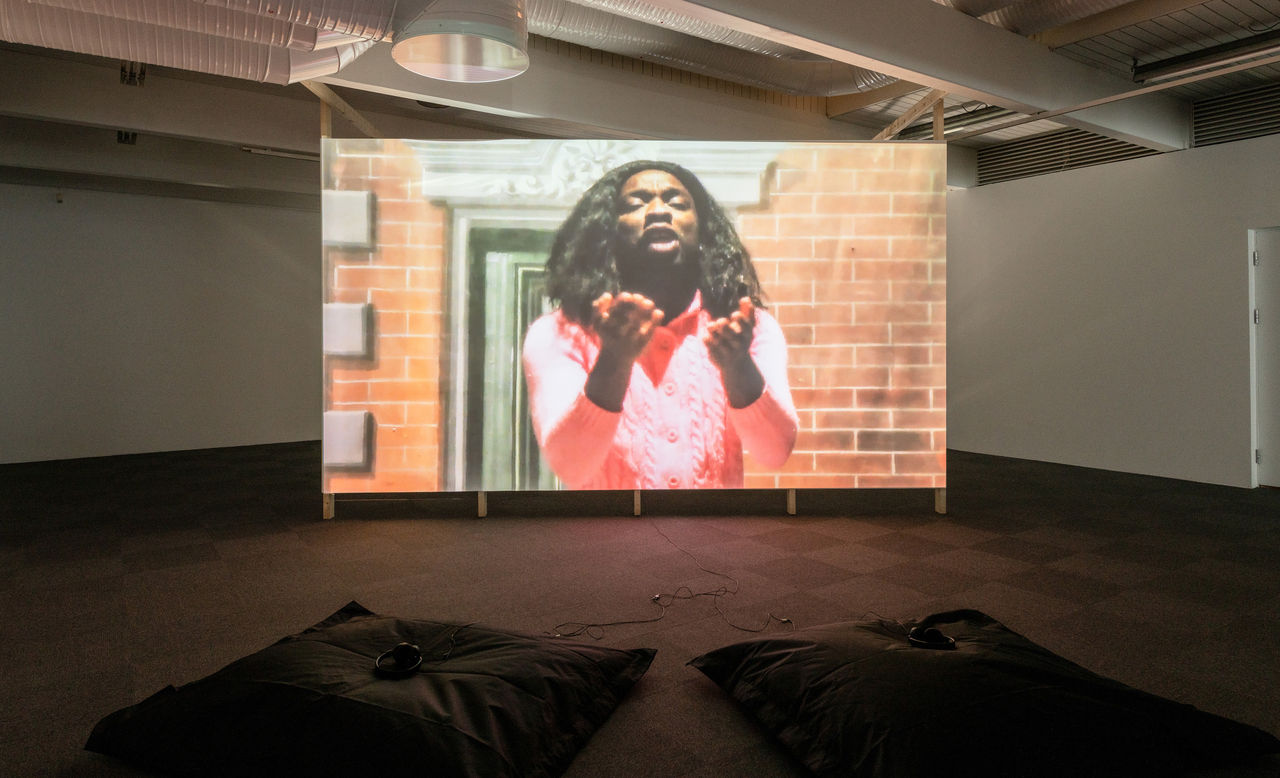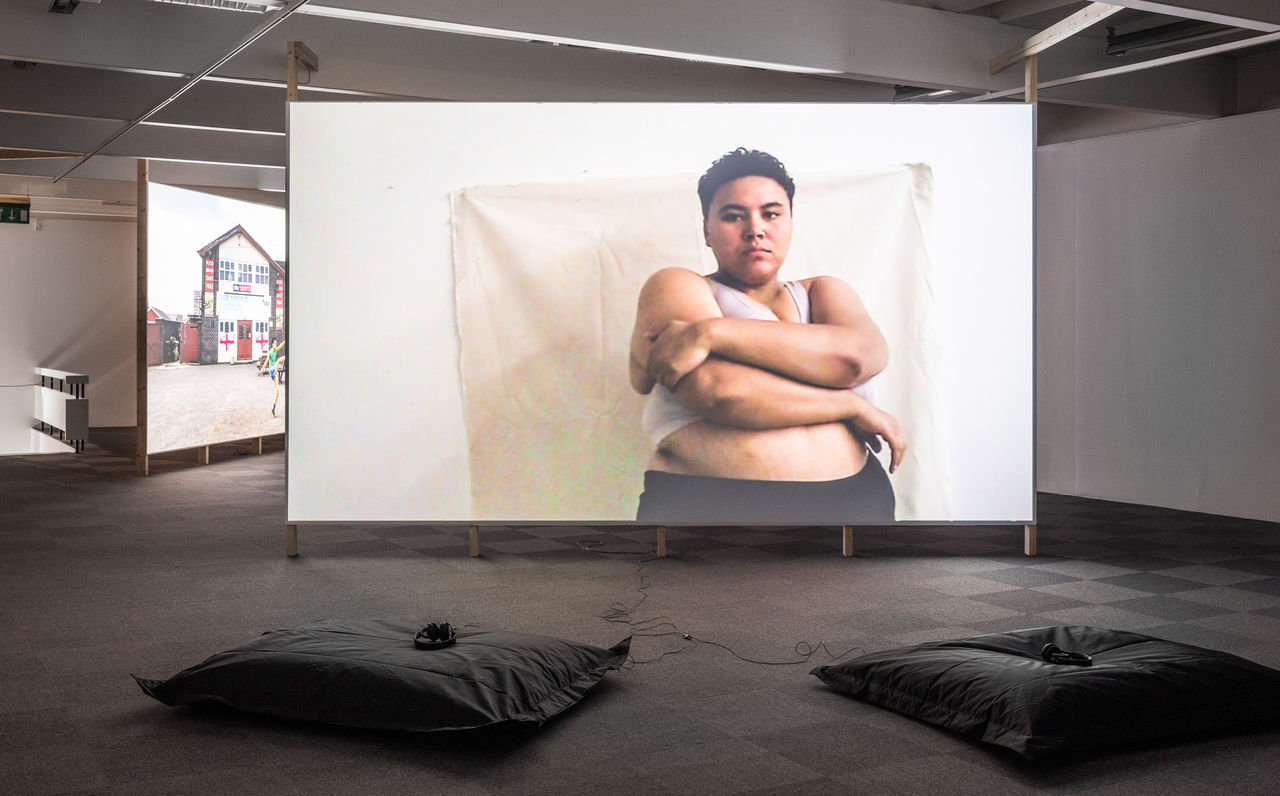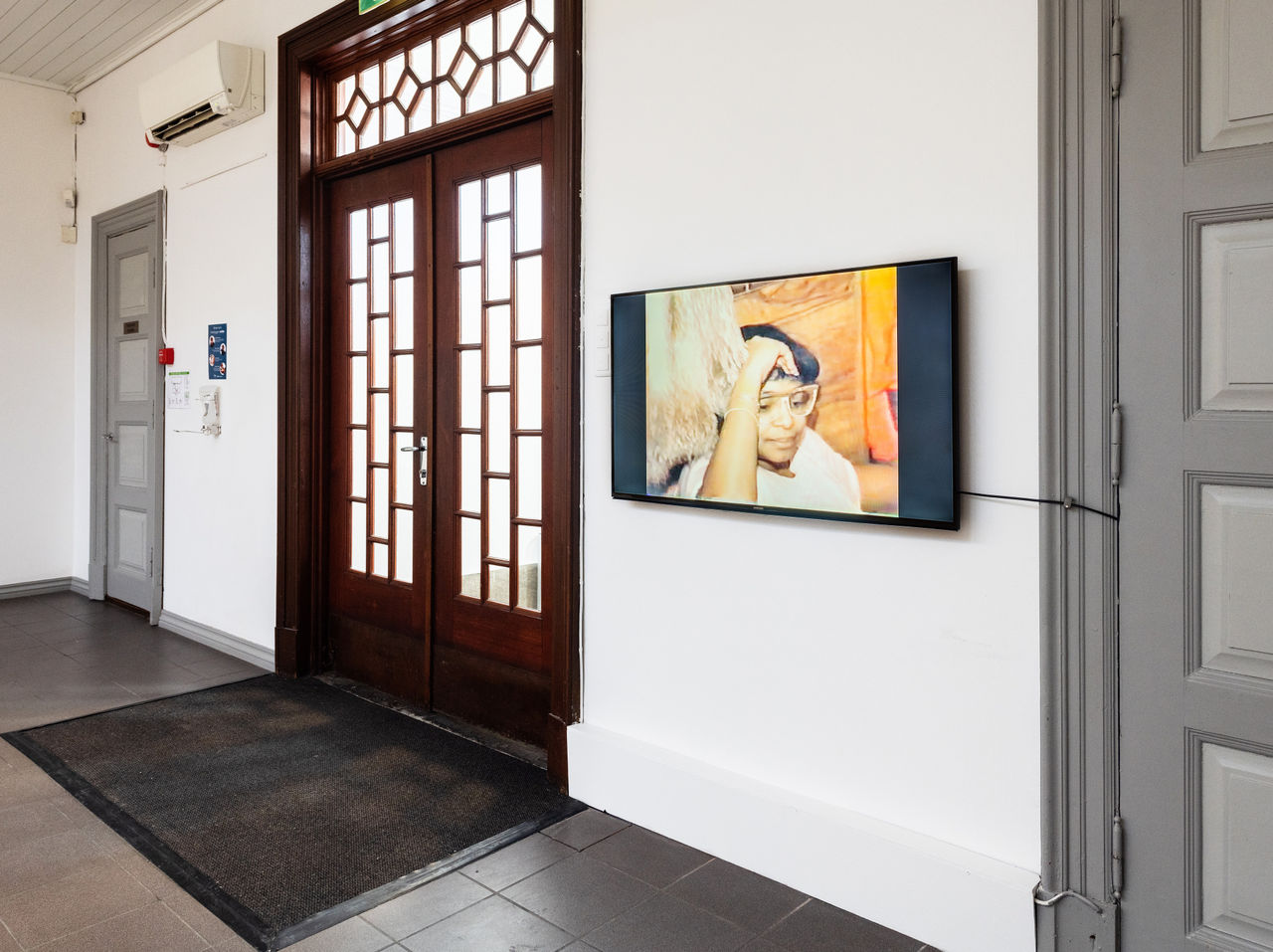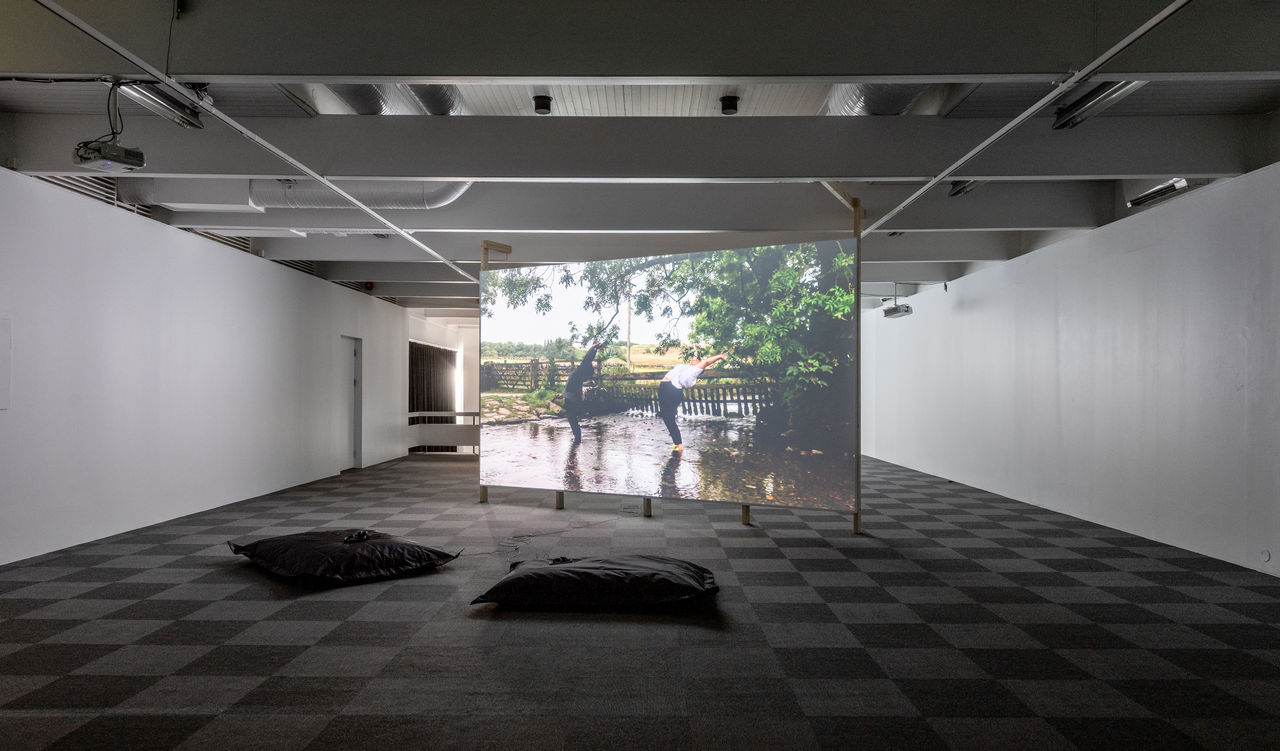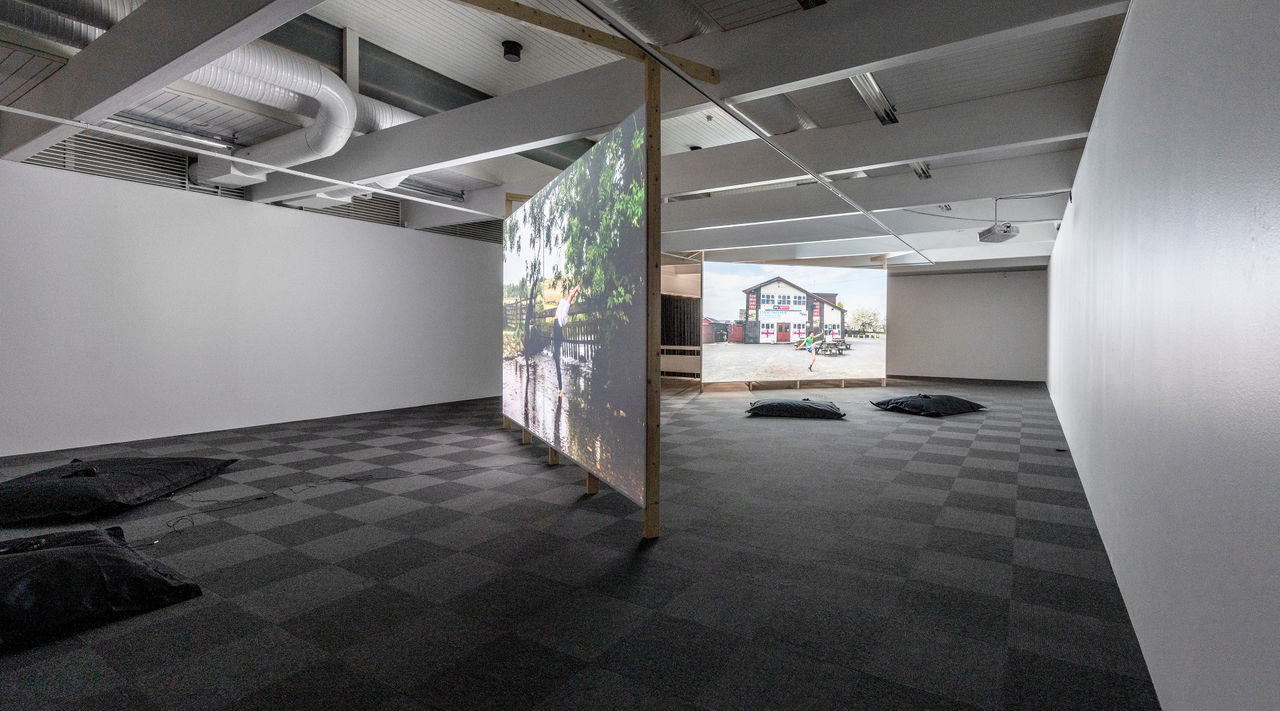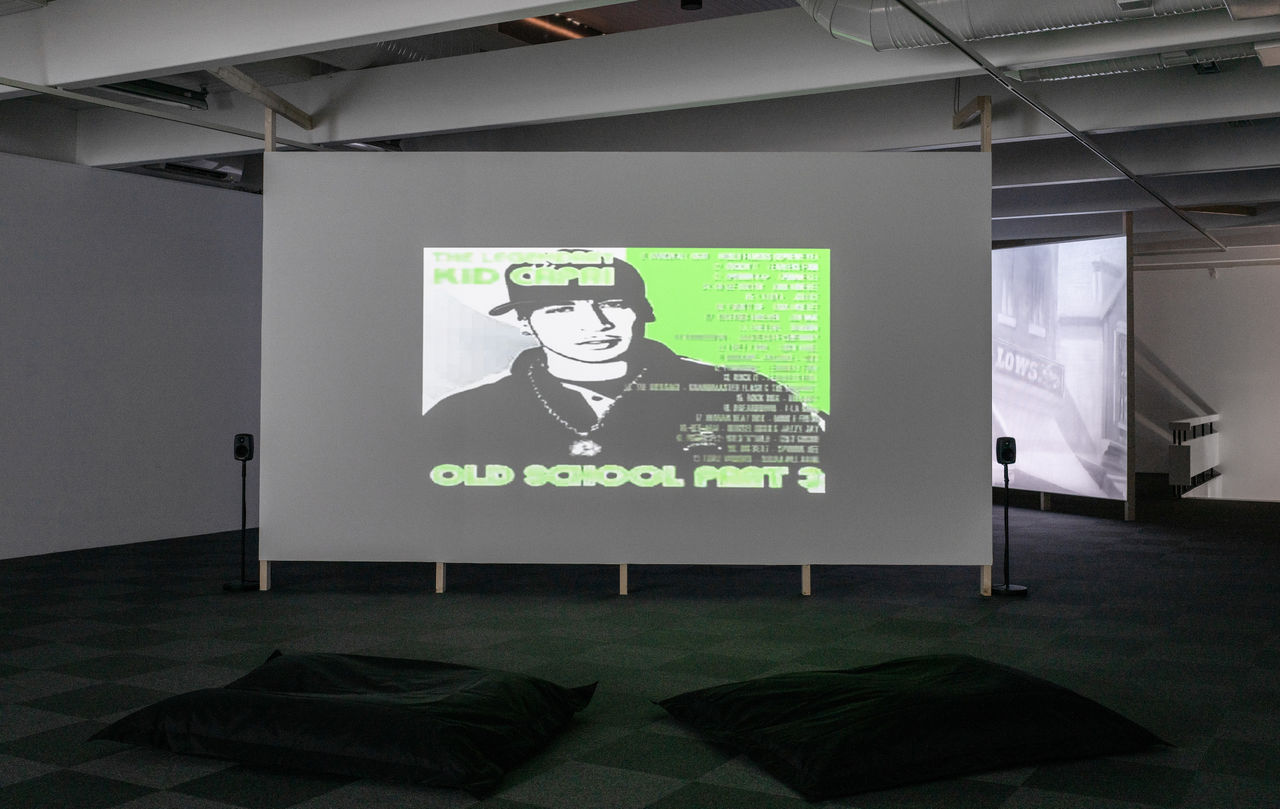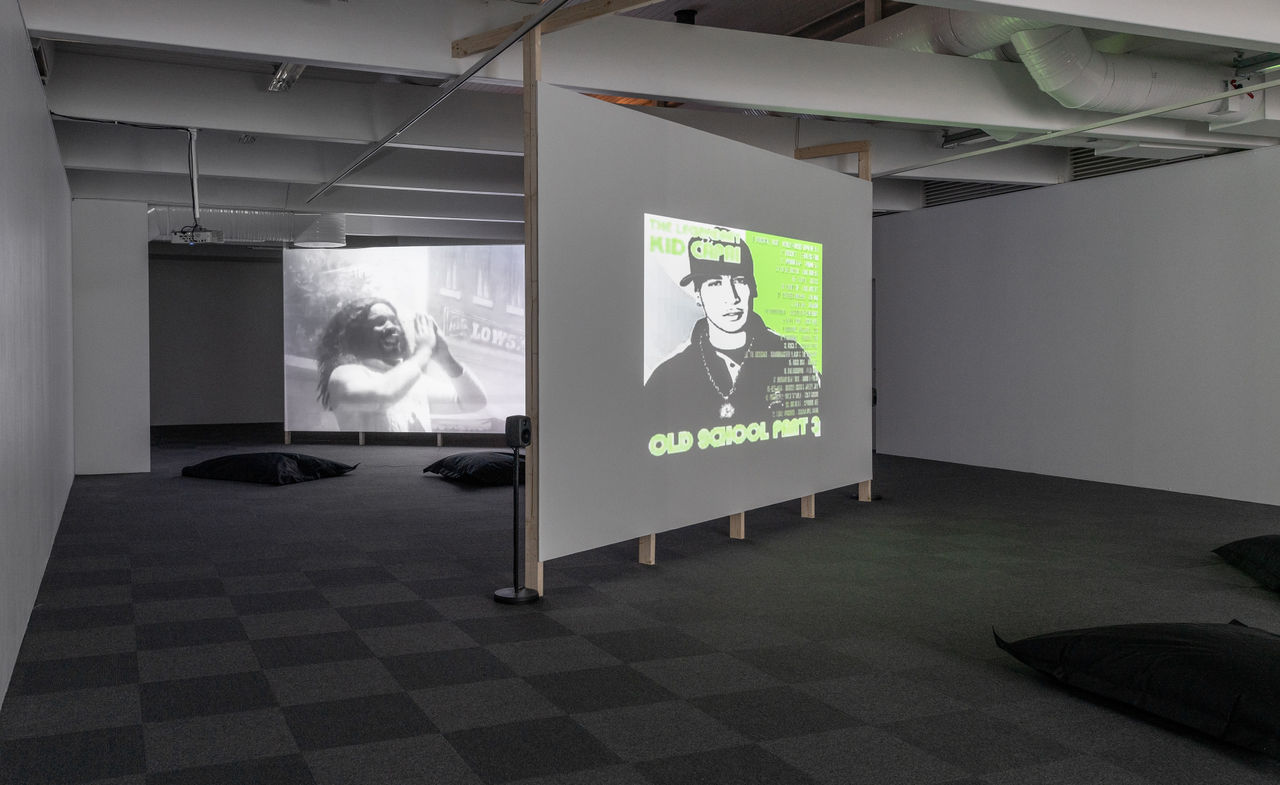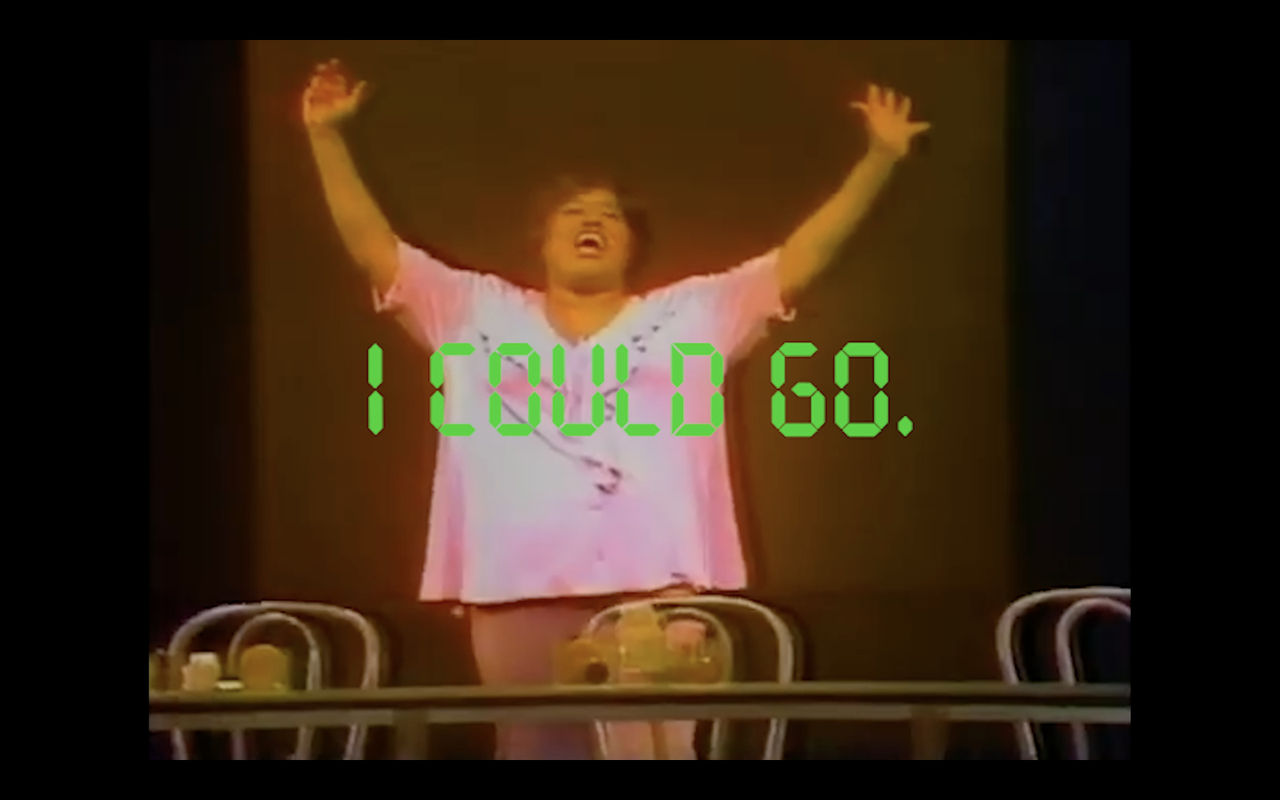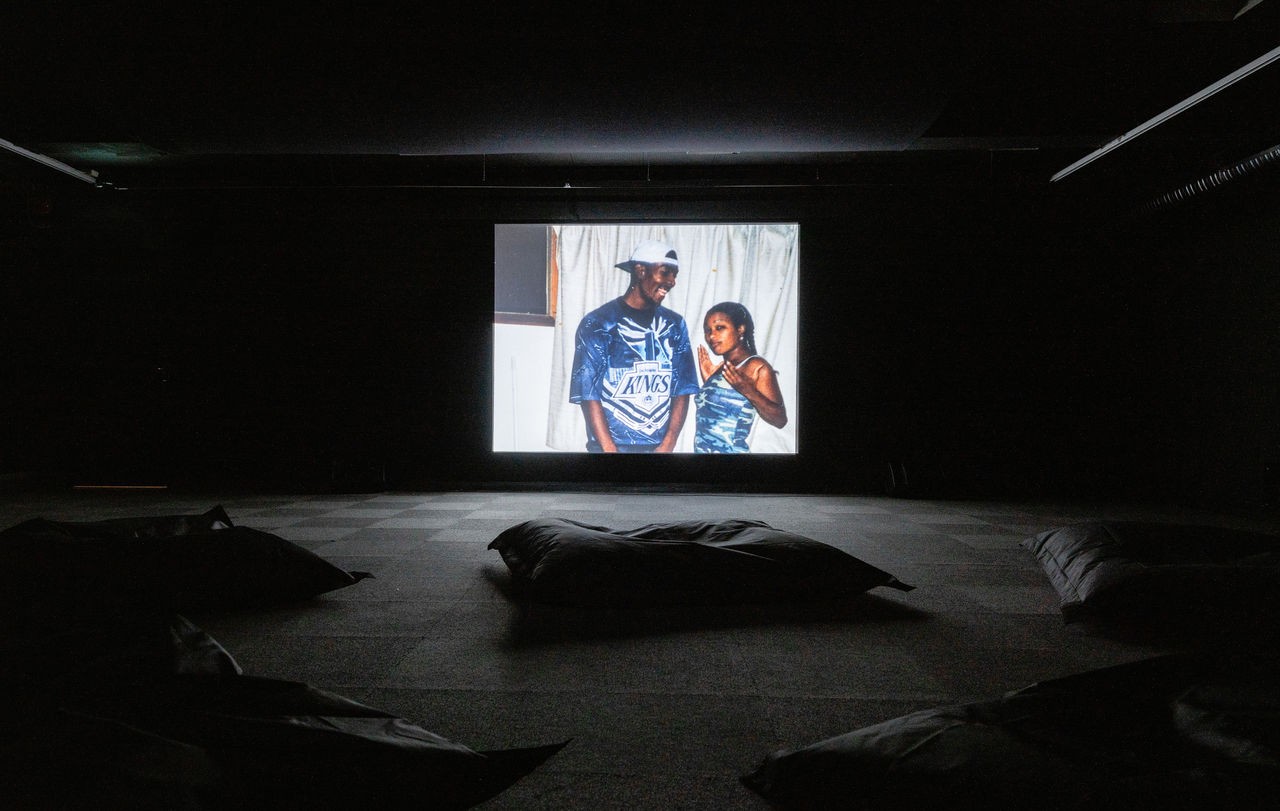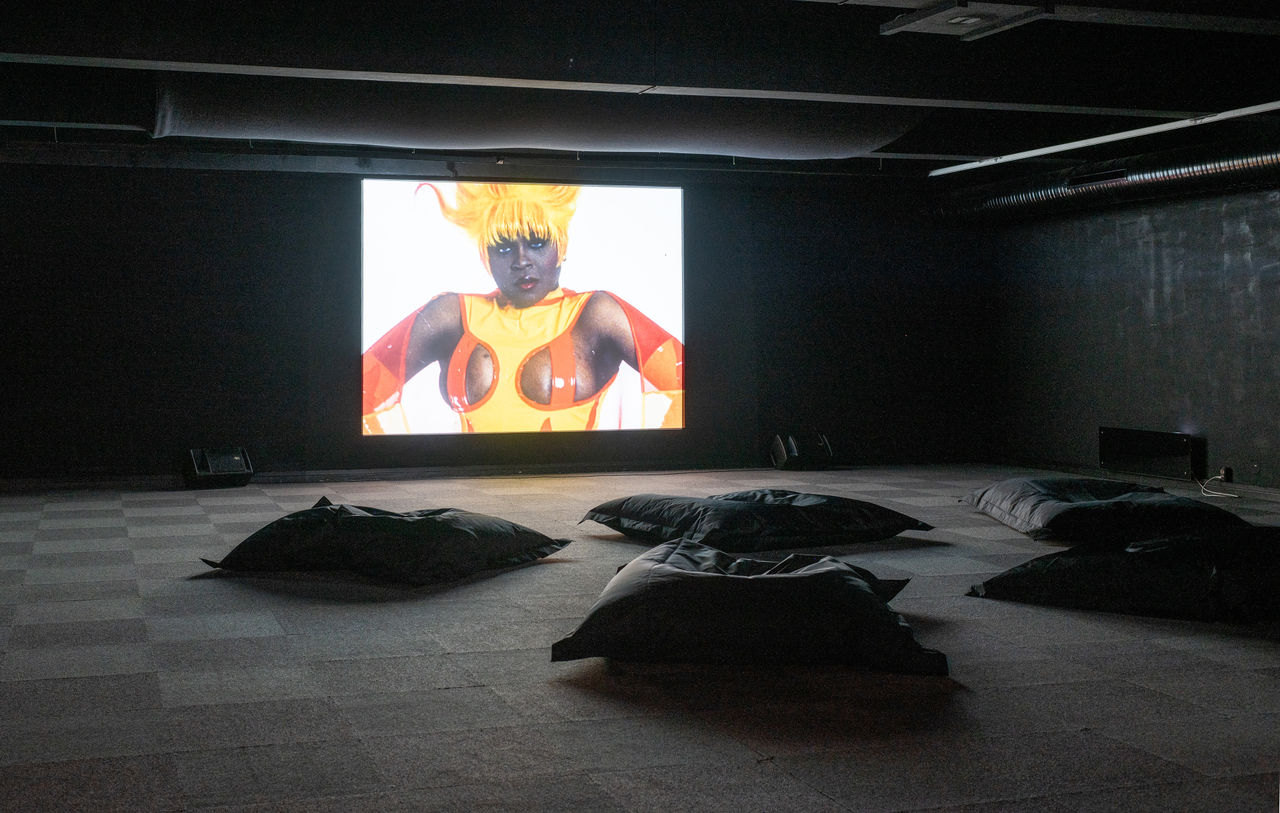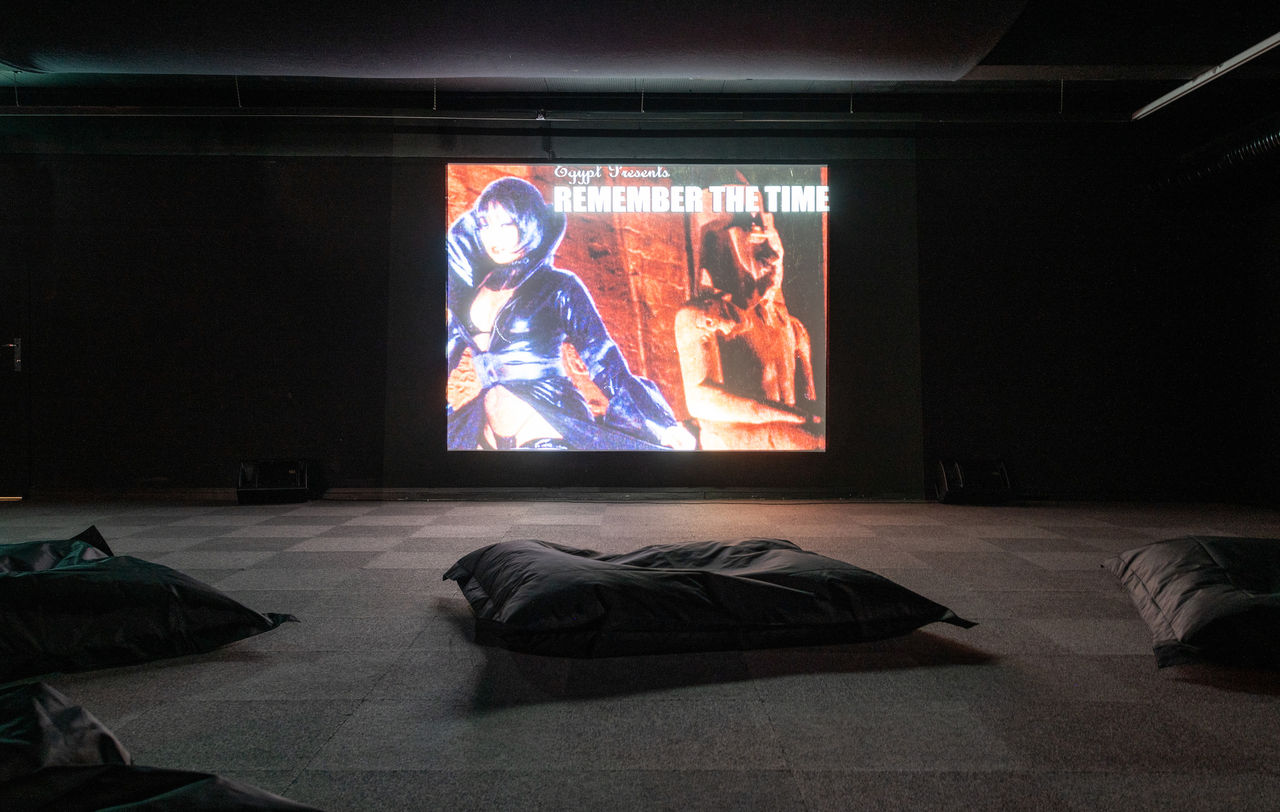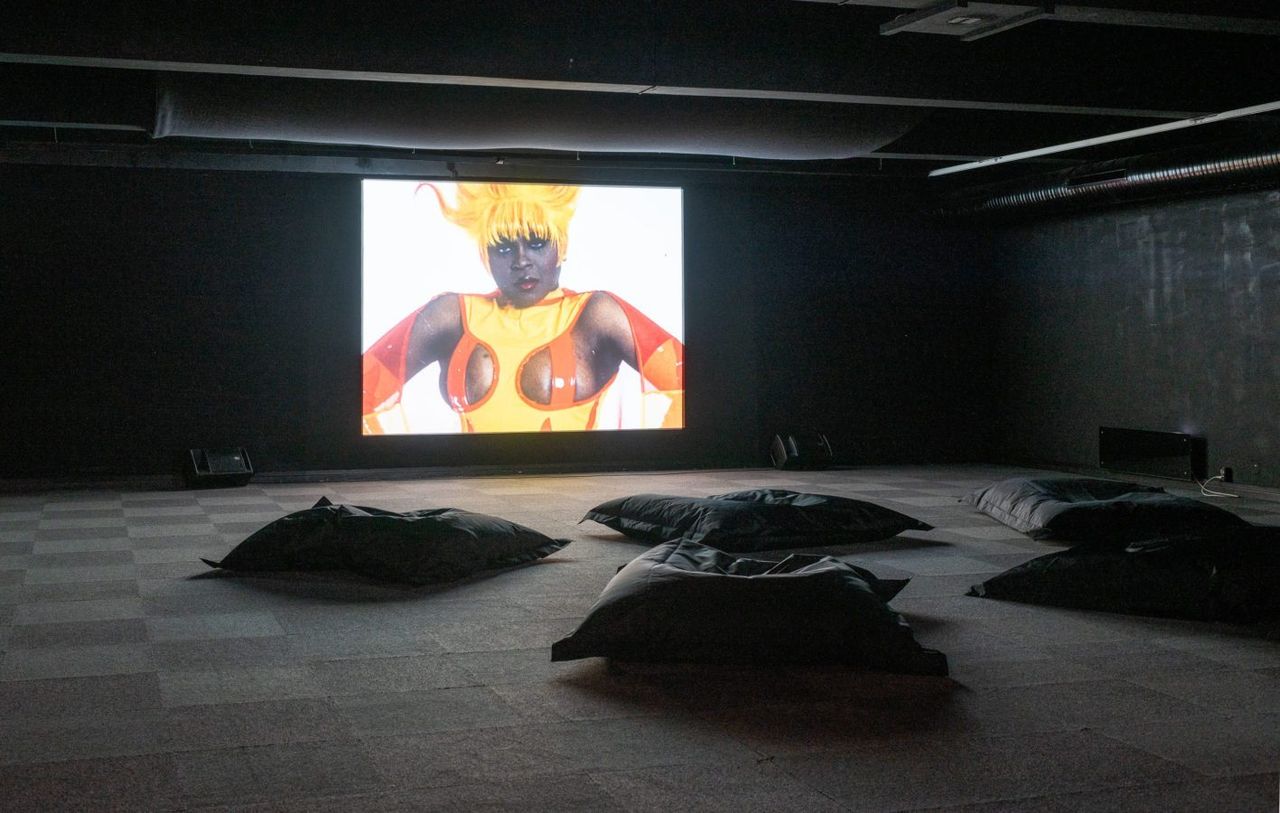
Lean /lēn/
verb: be in or move into a sloping position.
noun: a deviation from the perpendicular; an inclination.
“I prefer no curves at all, unless they be the // : This angle the cryptographic slant into figurative space is toward a poetics of internal excess[.]”
— Ronaldo V. Wilson [1]
The exhibition LEAN, curated by Legacy Russell, brings together artists Justin Allen, Jen Everett, Krista Gay, Devin Kenny, Kalup Linzy, Rene Matić, Sadé Mica, and Leilah Weinraub who, through movement, sound, and film, collectively congregate and confer toward lean as a Black vernacular and queer poetic proposition. For these eight artists — seven of whom were featured in the originating exhibition presented by Performa’s Radical Broadcast, and the eighth, Krista Gay, whose work debuts as an online-only feature via Kunsthall Stavanger’s website — Lean is an intimacy, collaboration, intergenerational, and international conviviality.
First imagined and shown as a
Lean /lēn/
verb: be in or move into a sloping position.
noun: a deviation from the perpendicular; an inclination.
“I prefer no curves at all, unless they be the // : This angle the cryptographic slant into figurative space is toward a poetics of internal excess[.]”
— Ronaldo V. Wilson [1]
The exhibition LEAN, curated by Legacy Russell, brings together artists Justin Allen, Jen Everett, Krista Gay, Devin Kenny, Kalup Linzy, Rene Matić, Sadé Mica, and Leilah Weinraub who, through movement, sound, and film, collectively congregate and confer toward lean as a Black vernacular and queer poetic proposition. For these eight artists — seven of whom were featured in the originating exhibition presented by Performa’s Radical Broadcast, and the eighth, Krista Gay, whose work debuts as an online-only feature via Kunsthall Stavanger’s website — Lean is an intimacy, collaboration, intergenerational, and international conviviality.
First imagined and shown as a digital exhibition for Performa’s Radical Broadcast, LEAN is now migrating for the first time to a physical format at Kunsthall Stavanger. Being sited in physical space away from the screen presents the exciting opportunity for the nine artworks in this exhibition to activate new ways of engaging with the artist-driven histories of the kunsthall as a political site of avant-garde exploration and creative experimentation. Convening here, these artists explore the intimacies of familial relationships and enact bodily interventions in public and private space, offering a radical proposal for new and exciting architectures while challenging Eurocentric constructs of site and time.
Theorist and professor Kemi Adeyemi observes: “[A] white ruling class [is] obsessed with, the verticality and perpendicularity of the 90° angle.”[2] Thus expansiveness of the lean here across these pages extends far beyond its definition of origin, an active refusal of a 90° that is, as Adeyemi notes, “distinctly gendered and racialized”. As a lexicon, lean is a suture, and a song; it throws shade, and makes it. Its constellation is far-reaching and galactic while still somehow dense, sensual and sticky. It is a visual axis and a line-break. Spiritual, it is what our hands do when they pray.
Lean holds us and holds us up, and as a 1972 singer-songwriter Bill Withers reminds us, “We all need somebody to lean on . . .”[3]. // Lean is the bounce, dissent, and sway of hip-hop group Dem Franchize Boyz on base, an entire club on an early-aughts dance floor snapping back to their “Lean Wit It, Rock Wit It”[4]. // Lean is the very essence and energy of the contrapposto, a classicised angularity made whole and holy by the blend, blur, and limens of a luminous blackness and queerness. // Lean is the birth of drag ballroom competitions in 1920s Harlem, New York City and the 1990s genesis of Atlanta trap music, bound in decadent conversation and entanglement across dancefloors and decades. // Lean is the exact radical repatriation that emancipates these canonized slants back into the world where they belong and, beyond the freeze of carrara marble, makes them move. // Lean is the sonic re/negotiation of sound in what is chopped and screwed as a hall-haunting alongside of, and in remix with, the innovations and technologies found in the notes and lines of musicians such as Julius Eastman, Alice Coltrane, and Nina Simone. // Lean is all at once a complex interdependence, codependency, community and kinship, a rhizomatic set of mathematical possibilities that break from the static and pose in lyrical abstraction.
Thus, to lean represents a gesture that forces an impossibility of physics: a falling without collapse, an epic draping that never meets the floor but instead floats, an image that defies imagination. When the sites we travel through are designed to surveil us, dictating how our bodies should move and feel, we who lean enact essential spatial and emotional labor, protective enclosures that break and remake space, decolonize time, remix memory, reformat care. As poet Harmony Holiday notes: “Now we have to thank the catastrophe for imbuing us with the stamina to reach ourselves at these endless slants[.]”[5] Leaning scores and slants with urgency, a performative and political proposal for new worlds to be dreamt up and built, and new ways of reading, listening, becoming, being.
Forever reaching somewhere between the horizon and the sky, this LEAN here and the artists therein offer windows into a networked architecture, an endless form of communication, a call awaiting a response, gorgeous glyphs of desire.
Text by Legacy Russell
1. Wilson, Ronaldo V. Poems of the Black Object. “VERGELIOIAN SPACE V: CALIBAN X”, p. 49. Futurepoem, 2009.
2. Adeyemi, Kemi. “Beyond 90°: The Angularities of Black/Queer/Women/Lean: Kemi Adeyemi (29.1).” Women & Performance, Women & Performance, 26 Feb. 2019, womenandperformance.org/....
3. Reference to a song by Bill Withers titled “Lean on Me” (1972).
4. Reference to a song by Dem Franchize Boyz “Lean Wit It, Rock Wit It” (2006).
5. Holiday, Harmony. “The Black Catatonic Scream .” Triple Canopy, 2020, canopycanopycanopy.com/....
Legacy Russell is a curator and writer. Born and raised in New York City, she is the Associate Curator of Exhibitions at The Studio Museum in Harlem. Russell holds an MRes with Distinction in Art History from Goldsmiths, University of London with a focus in Visual Culture. Her academic, curatorial, and creative work focuses on gender, performance, digital selfdom, internet idolatry, and new media ritual. Russell’s written work, interviews, and essays have been published internationally.
Curated exhibitions and projects include LEAN (2020) featuring Justin Allen, Jen Everett, Devin Kenny, Kalup Linzy, Rene Matić, Sadé Mica, and Leilah Weinraub for Performa's Radical Broadcast; This Longing Vessel : Studio Museum Artists in Residence 2019-20 featuring E. Jane, Elliot Reed, and Naudline Pierre (2020); Projects: Garrett Bradley (2020) and Projects 110 : Michael Armitage (2019), organized with Thelma Golden and The Studio Museum in Harlem at MoMA; Dozie Kanu : Function (2019), Chloë Bass : Wayfinding (2019), and Radical Reading Room (2019) at The Studio Museum in Harlem. She is the recipient of the Thoma Foundation 2019 Arts Writing Award in Digital Art, a 2020 Rauschenberg Residency Fellow, and a recipient of the 2021 Creative Capital Award. Her first book Glitch Feminism: A Manifesto (2020) is published by Verso Books. Her second book, BLACK MEME, is forthcoming via Verso Books.
b. 1992
Justin Allen (born in Arlington, VA; lives and works in Brooklyn, NY) [he/him] is a writer and performer whose recent performance-based work responds to and interacts with the history of hardcore punk and celebrates Black contributions to this creative work. “Explain Totality (version 3)” (2018) revisits one of these serial performances, originally staged in 2018 by Allen at the historical Judson Memorial Church in New York City as part of the ongoing experimental series Movement Research at the Judson Church. In this piece the artist reflects on growing up in an American suburb, intermittently breaking into a cover song of the hip-hop duo Rae Sremmurd’s 2018 release “Black Beatles”. Allen’s citation of Rae Sremmurd’s song merges the vernaculars of punk and hip-hop, paying homage to this intersection as a necessary conversation and contact point. The artist’s isolated gestures—skanking, windmills, the limber and stretch of his legs—score the movements found within, or as entry to, the collective act of moshing. The artist’s physical form and choreography assert an organic architecture, one intended to make and hold space intimately in opposition to, and in collaboration with, other bodies on a dancefloor. This collides and contrasts with Allen’s reflection on the histories of suburban development as being explicitly raced and classed, the suburbs themselves a noxious legacy of the project of American slavery and postbellum tactics of segregation and control.
Justin Allen experiments with performance, writing, linguistics, and the still and moving image to understand our relationships to time, social context, and place. He has read and performed at The Poetry Project, Movement Research at the Judson Church, The Shed, Kampnagel, and ISSUE Project Room where he is currently an artist-in-residence. His work has received support from Franklin Furnace and Foundation for Contemporary Arts.
b. 1981
Jen Everett (b. 1981, Detroit, MI; Lives and works in St. Louis, MO) [she/her] is an artist whose practice has evolved from photography-based to incorporating text, installation and time based media. Everett engages the question of the Black archive as a site of transmission, rupture, and interiority. Her interest in the intersections across site, time, and memory are heavily influenced by her undergraduate training in architecture.
Broadly, she is interested in the myriad ways Black people continue to produce and transmit knowledge in excess of formal structures. Her practice moves between lens-based media, installation and writing. Jen’s recent work considers the relationship between rupture and Black interiority through an investigation of the materials we collect, the information we hold in our bodies and where the two may converge. Jen received an MFA from Washington University in St. Louis where she was a Chancellor’s Graduate Fellow in the Sam Fox School of Design & Visual Arts. She earned a Bachelor of Architecture from Tuskegee University. Her work has been shown at the Krannert Art Museum, Seattle University’s Hedreen Gallery, SPRING/BREAK Art Show New York, Leo Model Gallery at Hampshire College, Vox Populi – Philadelphia, and Gallery 102 in Washington DC. Jen’s work has been presented during lectures at the Saint Louis Art Museum and Harvard University and has appeared in Transition and SPOOK magazines. Her work was published in Color Theory (Wolfman Books, 2019) and Undertow (Silent Face Projects, 2018). Jen has been an artist in residence at the Vermont Studio Center, Atlantic Center for the Arts and ACRE. Her work is in the collection of the Museum of Contemporary Photography (MoCP) at Columbia College – Chicago.
b. 1998
Krista Gay (b. 1998, Los Angeles, CA; Lives and works in New York, NY) [she/her] is an interdisciplinary artist whose work engages, as Gay puts it, “video archives sourced via cyberspace”. With a practice spaning text, sound, photography, and moving image Gay explores and examines media representations of Black womanhood as they appear online, and as different publics participate in the act of viewership via the proxy, prosthetic, and black electric mirror of machinic technologies. Through this work the artist traverses the volatile historical and contemporary relationships of the Black woman to the constructs of cyborg, slave, robot, meme, and machine. Gay’s critique of Black womanhood in the media—and, via extension, Black femme sexuality—cites the troubled binary assignment of Black femmes being either exalted and abject, worshipped or desecrated.
As an artist Gay is working through photography, video, language, and sound installation to study the sciences and histories of the Black American body. Her work cites her own contemporary position and lived experience as a Black woman in active dialogue and intersection with the ongoing subjugation of, and experimentation on, Black women in the name of scientific research.
b.1987
Devin Kenny is an interdisciplinary artist, writer, and musician. Raised on the south side of Chicago, Illinois, he relocated to New York, to study at The Cooper Union as a teenager. He continued his practice through the Bruce High Quality Foundation University (NYC), Skowhegan School of Painting and Sculpture (Madison, Maine), SOMA Summer (Mexico City), and the Whitney Independent Study Program (NYC), doing collaborations with Justin Allen, Lucas Pinheiro, the Center for Experimental Lectures, Triple Canopy, Rhizome, Andrea Solstad, unbag, and various art and music venues in New York, Chicago, Los Angeles, Houston, and elsewhere including The Kitchen, Goethe Institut, Recess, Julia Stoschek Collection Düsseldorf, CAMH, OCCII, REDCAT, MoMa PS1, and Performance Space. He received his MFA in 2013 from UCLA.
Through performance, objects, video, photography, music, painting, and text, Kenny investigates the process of identity construction, particularly in American cities like the ones he grew up in, and identity construction online. As Kenny’s heritage is impacted by the Maafa, or the transatlantic slave trade, a major question of his work is if the syncretism and cultural exchanges that occurred as a result of that history laid a foundation for network culture, even before the existence of telecommunications technology.
b. 1977
Kalup Linzy was born in Florida and is currently a Tulsa Artist Fellow. His work thematically explores sexuality, gender stereotypes, cultural identities, and his childhood upbringing through soap opera based video and performance works. Linzy’s recent solo exhibitions include Sundance Film Festival, Park City, UT; Berkeley Art Museum, Berkeley, CA; The Studio Museum in Harlem, New York, NY; and LAX ART, Los Angeles, CA, among others. Recent group shows include The Whitney Museum of American Art, New York, NY; The Museum of Modern Art, New York, NY; and MoMA PS 1, Long Island City, NY, among others. Linzy has been the recipient of numerous awards including a grant from the John Simon Guggenheim Memorial Foundation fellowship, Creative Capital Foundation grant and a New York Foundation for the Arts Fellowship in Film and Video. His work is in the public collections at The Studio Museum in Harlem, Whitney Museum of American Art, Museum of Modern Art, and The Metropolitan Museum of Art. He is represented by David Castillo Gallery in Miami Beach and The Breeder Gallery in Athens, Greece.
b. 1997
Rene Matić is an artist currently working in London. Their work brings together themes of post-blackness, glitch feminism and subcultural theory in a meeting place they describe as rude(ness) – bringing to light (or dark) the fated conflicts and contradictions that one encounters while navigating the world in a body like their own. Matić’s research reaches back to post-war Britain and the survival tactics and ‘tap dances’ of Britain’s Brown babies. They take their departure point from dance and music movements such as Northern soul, Ska and 2-Tone. Matić’s current work predominantly explores the Skinhead movement, its founding as a multicultural marriage between West Indian and white working-class culture and its subsequent co-option by far-right white supremacists. They use this as a metaphor to examine their own experience of living in the Black British diaspora, to excavate white jealousy, the continued legacy of colonialism and the fear of a Black planet - all things which find convergence within and upon their mixed-race identity.
They have exhibited and performed internationally at galleries including: Bold Tendencies, London, UK; Saatchi Gallery, London, UK: Arcadia Missa, London, UK; The Royal Standard, Liverpool, UK; VITRINE, Digital, Online; Rile Space, Brussels, BE; Hume Gallery, Chicago, US; Lesbiennale 2019, Online; Autograph ABP, London, UK; Protein Gallery, London, UK; Attic Space, Nottingham, UK; Atrium Gallery, London , UK; Copeland Gallery, London, UK; Ugly Duck Gallery, London, UK. Commissions include the 'Black Cultural Archives' by Tate x Mayor of London (2018). Matić is currently included in the Bloomberg New Contemporaries 2020 and the group show 'Friends and Friends of Friends' at Schlossmuseum, Linz, AT (until January 2021). Matić’s first solo show debuted in London at VITRINE (October 2020).
b. 1995
Sadé Mica lives and works in Manchester, UK. Their practice is rooted in exploring the self. The self in relation to gender and performance; how the world around them affects their relationship to their queerness and the body they inhabit. How movement is policed by environment and us and how fraught the control we have of our perception is when thrust outside of solitary environments. They explore how their body is freed and restricted, liberating themselves, their limbs in the British countryside, posturing against vast landscapes foreign to them, capturing the stillness of their form and thoughtful movements as well as those more chaotic and less considered. They use textiles to eschew the expectation of stealth bestowed upon trans people and their bodies and embrace unmasking the performative nature of gender, placing the onus upon those who aren’t aware of the sacrifices made to find peace within one's body in the way that they are.
Recent exhibitions include: Natural Encounters, Leeds Art Gallery (2020); To The Unknown, Somerset House Studios (2020); Found In Translation, Trans Vegas Digital (2020); Genders, Science Gallery, London (2020); It Teks Time solo show, Outpost, Norwich (2020); GIVIN U COY GIVIN U SMIZE, IMT Gallery, London (2020).
b. 1979
Leilah Weinraub is an artist and film director that lives between Los Angeles and New York. Since premiering in the 2018 Berlin Biennial and at the 2017 Whitney Biennial, Weinraub’s film SHAKEDOWN has toured internationally to various institutions, including MoMA PS1, New York; MOCA, Los Angeles; CAAM, Los Angeles; ICA, London; Centre d’Art Contemporain, Geneva, as well as multiple film festivals. As CEO and co-founder of Hood by Air, the New York-based fashion collective known for luxury streetwear, Weinraub radicalized fashion by championing what she calls “modern people”: the rising class of consumers who subvert traditional markers of race, class, and gender and revel in freedom, lawlessness, and spectacle. As a filmmaker, Weinraub has documented such unacknowledged tastemakers, particularly those belonging to queer, autonomous communities of color whose creative output is often plundered by mass culture and whose stories are rarely told on their own terms.
